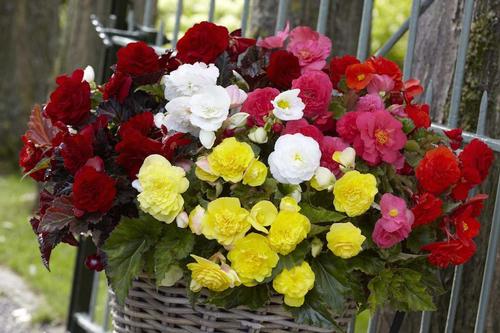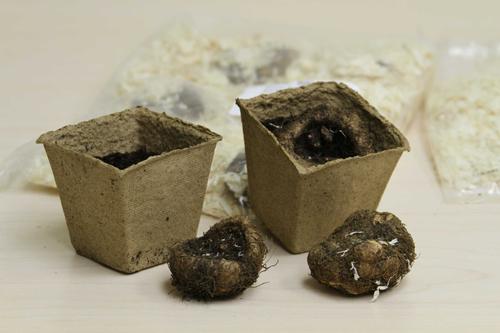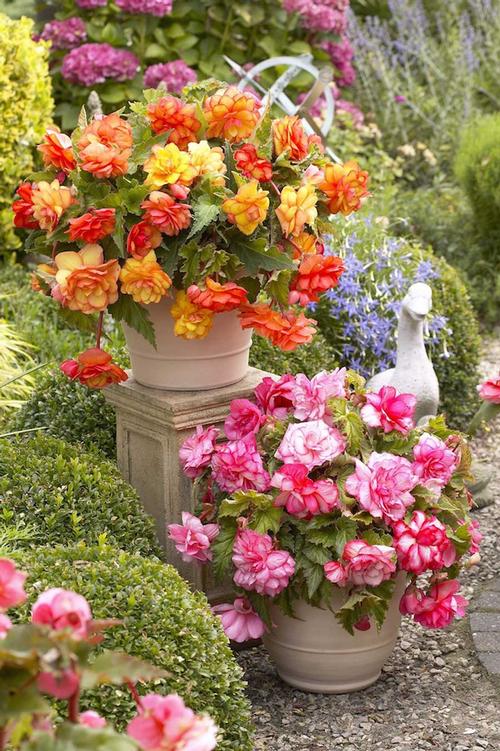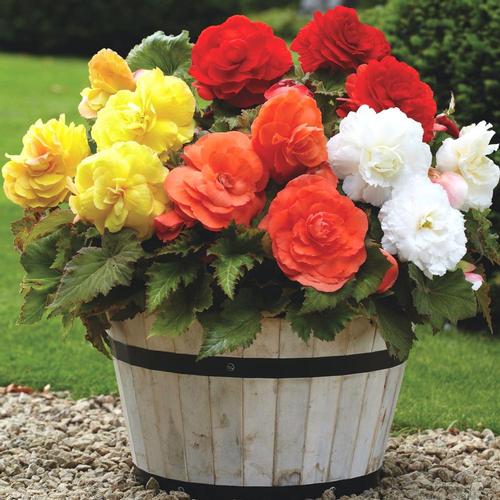How to Be Successful With Tuberous Begonias
For bold color in shady gardens, it’s hard to beat tuberous begonias. These lush plants have attractive foliage and big, rose-like flowers that bloom continuously from midsummer to frost. Planted in window boxes, hanging baskets, decorative urns or garden beds, they make it easy to dress up any outdoor living space.
Get To Know Your Begonias
Most tuberous begonias have an upright growth habit, but there are also cascading types that are perfect for hanging baskets. Flower sizes also vary. These include single-flowered begonias such as Bertini, compact types with 2 to 3” flowers such as Non-Stops, hanging types such as Golden Balcony, and the most popular ones, with big, 5 to 8” blossoms, such as Roseform Scarlet, Ruffled Yellow Fimbriata and Superba Mix.

Pre-Sprout The Tubers
A begonia tuber is shaped like a little brown bowl. Sprouts emerge from inside the cupped area and roots form on all sides of the tuber. For best results, encourage the tubers to sprout before planting them in pots or in the garden. Put them in a warm (70°F) area with indirect light. Small red buds will appear within a few weeks, followed by sprouts. For photos, see: Tuberous Begonias: Which End is Up?

Know When to Plant
Tuberous begonias are sensitive to cold and should not be put outdoors until the nights are above 50°F. For earlier blooms, start your begonias indoors, eight weeks before the last frost date. Plant the tubers 1” deep in moist growing mix and water sparingly. When the plants have one or two leaves, transplant them into individual 8” pots or combine several in a larger container. If you are planting directly into the garden, position the sprouted tubers about 5” apart and cover them with 1” of soil. Water lightly until the plants have several sets of leaves. Be careful not to overwater.
To learn more and see recommended planting dates, you may be interested in reading Starting Tuberous Begonias Indoors.

Location. Location. Location.
Begonias are tropical plants, but their foliage and flowers can be damaged by too much sun, and they will not grow in hot, dry weather. Tuberous begonias prefer the filtered light beneath high trees, or at least 4 hours of morning sun.
If you are planting your begonias in a garden bed, make sure to choose a spot with the right amount of light and well-drained soil. If you are growing them in pots, use a high quality, humus-rich growing mix. Pots must have drainage holes on the bottom, so the roots can breathe, and excess water can drain away.
Care and Feeding
Providing good air circulation and removing spent blossoms and wilted leaves, will help your plants stay healthy. Tuberous begonias have brittle stems, so they need to be protected from strong winds. Upright types with large flowers benefit from being staked. This will help keep the stems from breaking off at the tuber. Use stretch-ties to avoid damaging the stems.

Watering
Begonias need to be watered consistently. But between waterings, it’s best to let the top inch or two of soil get dry to the touch. Check your begonias often during hot, dry weather. If the plants start dropping flowers or wilting, it means the soil is either too wet or too dry. Focus your watering so the foliage stays as dry as possible, or can dry quickly after watering. Don't allow water to stand in saucers. For maximum flower production, fertilize your begonias weekly with quarter-strength liquid fertilizer.

Aftercare in Growing Zones 4-7
Begonias may be treated as annuals, or you can store the tubers indoors and replant them again next spring. If the plants are in pots, move the pots to a protected location before risk of frost. Stop watering and let the plants die back naturally. Dig up the tubers (the stems should pull away easily) and store them in peat moss or in individual paper bags, in a dark, frost-free place at about 50°F.
Aftercare in Growing Zones 8-11
In warm climates, begonias will begin to enter dormancy in late fall. Flowering slows down, and the foliage will start to yellow. If the plants are in pots, simply stop watering and move the pots to an area where the soil will stay completely dry during the winter. The tubers may remain right in the pots. If your begonias are in the ground, you’ll need to dig up the tubers so they are not in danger of rotting during the winter. Let them dry in a protected area and then store them until spring.


